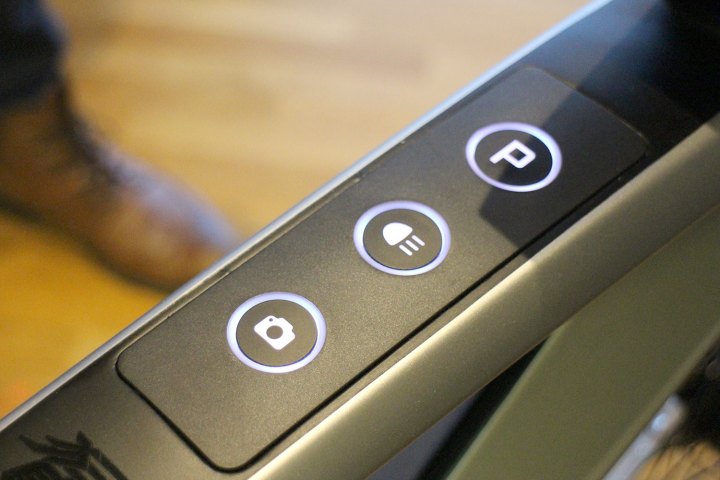In the near future, you could be riding a smart bike that shoots lasers out of each side. Except the beams aren’t there to carve through pedestrians like lightsabers as you zoom past, or vaporize cars, but for safety. In fact, they may end up keeping you from reaching your own gory end under the wheels of a massive truck. It’s just one of the cool features on the Le Super Bike, a carbon fibre or titanium framed bike that essentially has a smartphone built into the handle bars, giving it the same kind of connected capabilities we usually associate with a car. We got the chance to sit on the bike, try out the smart features, and yes, the laser beams.
The lasers are most useful at night, and activated automatically when the front and rear lights are turned on.
The lasers are most useful at night, and activated automatically when the front and rear lights are turned on. This is automatic too, thanks to an ambient light sensor on the handle bars. The laser beams paint a parallel line on the road running down either side of the bike, about two feet out from the pedals. The idea is this is the minimum amount of space the rider needs, and the beams help drivers judge passing maneuvers. Or, depending on how annoying a rider you are, a decent target at which someone will aim.
Le Super Bike is made by LeEco, formerly known as Letv, the giant Chinese company that impressed us earlier in the year with the Snapdragon 820 Le Max Pro smartphone. That’s not the device fitted into Le Super Bike’s handle bars, though; It’s much smaller and nowhere near as powerful. The screen measures 4-inches and while it runs Android, it’s covered in a custom UI, which disappointingly is called BikeOS and not Le BikeOS. We would have Le liked that better. It’s powered by a 1.3GHz processor and 4GB of RAM.
The phone shows a variety of details regarding road speed, navigation, and fitness statistics provided by sensors mounted underneath the hand grips. It also works as a music player — complete with a loud speaker to annoy the general public — and as a phone, thanks to a 4G connection. The screen is secured using a fingerprint sensor, which also locks the bike itself, and the whole thing is powered by a battery that can be charged using a battery pack, or when you’re cycling along thanks to the wheel-mounted power system. Next to each hand grip are thumb controls for the music volume, mode, and for little indicator lights fixed to the tips. Down by the rear wheel is a sensor for tracking pedal rotations.
On the top tube of the bike (that bar that runs from the handle bars to under your seat) are three buttons: one for the front and rear lights; one for the power; and the other for a camera. This is an optional accessory that fits on the handlebars, and can be used to film your sweet jumps, or final moments. The camera can be removed for security, but the bike’s control screen is part of the frame, so you can’t take it out. The Super Bike’s wheels are automatically locked to prevent anyone riding away on it, but you’ll still have to use a lock and chain to stop it being carried away. There’s no chance of the wheels locking if the smart system runs out of power, or does so before you go to ride home from work, because the system ensures the wheels are unlocked a few minutes before the battery runs out.
LeEco already sells the Super Bike in China, where the standard model costs around $800, and Will Park, the company’s head of social and marketing, told Digital Trends the intention is to have a Super Bike on sale in the U.S. later this year, although there are no release details or prices yet. We can’t wait to give it a try on the road.




